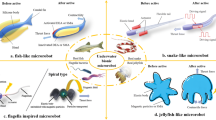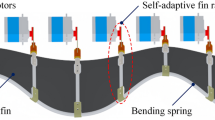Abstract
In this paper, a bionic mantis shrimp amphibious soft robot based on a dielectric elastomer is proposed to realize highly adaptive underwater multimodal motion. Under the action of an independent actuator, it is not only able to complete forward/backwards motion on land but also has the ability of cyclically controllable transition motion from land to water surface, from water surface to water bottom and from water bottom to land. The fastest speed of the soft robot on land is 170 mm/s, and it can crawl while carrying up to 4.6 times its own weight. The maximum speeds on the water surface and the water bottom are 30 mm/s and 14.4 mm/s, respectively. Furthermore, the soft robot can climb from the water bottom with a 9° slope transition to land. Compared with other similar soft robots, this soft robot has outstanding advantages, such as agile speed, large load-carrying capacity, strong body flexibility, multiple motion modes and strong underwater adaptability. Finally, nonlinear motion models of land crawling and water swimming are proposed to improve the environmental adaptability under multiple modalities, and the correctness of the theoretical model is verified by experiments.













Similar content being viewed by others
Data availability
All data included in this study are available upon request by contact with the corresponding author.
Availability of Data and Materials
The data that support the findings of this paper are available from the corresponding author, [Yuan Chen], upon reasonable request.
References
Garayev, K., & Murphy, D. W. (2021). Metachronal swimming of mantis shrimp: kinematics and interpleopod vortex interaction. Integrative and Comparative Biology, 61(5), 1631–1643.
Gu, Y. Q., Xia, K., Zhang, W. Q., Mou, J. G., Wu, D. H., Liu, W., Xu, M. S., Zhou, P. J., & Ren, Y. (2021). Airfoil profile surface drag reduction characteristics based on the structure of the mantis shrimp abdominal segment. Archive of Applied Mechanics, 91, 919–932.
Graham, Z. A. (2021). Moving in fast waters: The exaggerated claw gape of the new river crayfish (Cambarus chasmodactlyus) aids in locomotor performance. Biology Letters, 17(5), 20210045.
Ren, K., & Yu, J. C. (2021). Research status of bionic amphibious robots: A review. Ocean Engineering, 227, 108862.
Rafeeq, M., Toha, S. F., Ahmad, S., & Razib, M. A. (2021). Locomotion strategies for amphibious robots-a review. IEEE Access, 9, 26323–26342.
Youn, J. H., Jeong, S. M., Hwang, G., Kim, H., Hyeon, K., Park, J., & Kyung, K. U. (2020). Dielectric elastomer actuator for soft robotics applications and challenges. Applied Sciences, 10(2), 2–32.
Cocuzza, S., Doria, A., & Reis, M. (2021). Vibration-based locomotion of an amphibious robot. Applied Sciences, 11(5), 2–20.
Abbaszadeh, S., Leidhold, R., & Hoerner, S. (2022). A design concept and kinematic model for a soft aquatic robot with complex bio-mimicking motion. Journal of Bionic Engineering, 19(1), 16–28.
Du, Z. W., Fang, H. B., & Xu, J. (2022). Snake-worm: A bi-modal locomotion robot. Journal of Bionic Engineering, 19, 1272–1287.
Li, G. R., Chen, X. P., Zhou, F. H., Liang, Y. M., Xiao, Y. H., Cao, X. N., Zhang, Z., Zhang, M. Q., Wu, B. S., Yin, S. Y., Xu, Y., Fan, H. B., Chen, Z., Song, W., Yang, W. J., Pan, B. B., Hou, J. Y., Zou, W. F., He, S. P., … Yang, W. (2021). Self-powered soft robot in the mariana trench. Nature, 591(7848), 66–71.
Ahmed, F., Waqas, M., Shaikh, B., Khan, U., Soomro, A. M., Kumar, S., Ashraf, H., Memon, F. H., & Choi, K. H. (2022). Multi-material bio-inspired soft octopus robot for underwater synchronous swimming. Journal of Bionic Engineering, 19, 1229–1241.
Lee, Y., Song, W. J., & Sun, J. Y. (2020). Hydrogel soft robotics. Materials Today. Physics, 15(6), 100258.
Traver, J. E., Nuevo-Gallardo, C., Rodríguez, P., Tejado, I., & Vinagre, B. M. (2022). Modeling and control of IPMC-based artificial eukaryotic flagellum swimming robot: Distributed actuation. Algorithms, 15(6), 181.
Fan, J. Z., Wang, S. Q., Yu, Q. G., & Zhu, Y. H. (2020). Experimental study on frog-inspired swimming robot based on srticulated pneumatic soft actuator. Journal of Bionic Engineering, 17(2), 270–280.
Ding, L., Niu, L. Z., Su, Y., Yang, H. G., Liu, G. J., Gao, H. B., & Deng, Z. Q. (2022). Dynamic finite element modeling and simulation of soft robots. Chinese Journal of Mechanical Engineering, 35(1), 1–11.
Li, J. P., Cai, J. J., Wan, N., Hu, Y. L., Wen, J. M., Kan, J. W., Chen, S., & Zhao, H. W. (2021). A novel bionic piezoelectric actuator based on the walrus motion. Journal of Bionic Engineering, 18(5), 1117–1125.
Manamanchaiyaporn, L., Xu, T. T., & Wu, X. Y. (2020). Magnetic soft robot with the triangular head–tail morphology inspired by lateral undulation. IEEE/ASME Transactions on Mechatronics, 25(6), 2688–2699.
Wang, S., Huang, B., McCoul, D., Li, M. Y., Mu, L. L., & Zhao, J. W. (2019). A soft breaststroke-inspired swimming robot actuated by dielectric elastomers. Smart Materials and Structures, 28(4), 045006.
Gu, G. Y., Zou, J., Zhao, R. K., Zhao, X. H., & Zhu, X. Y. (2018). Soft wall-climbing robots. Robotics, 3(25), eaat2874.
Cao, J. W., Qin, L., Liu, J., Ren, Q. Y., Foo, C. C., Wang, H. Q., Lee, H. P., & Zhu, J. (2018). Untethered soft robot capable of stable locomotion using soft electrostatic actuators. Extreme Mechanics Letters, 21, 9–16.
Youn, J. H., Jeong, S. M., Hwang, G., Kim, H., Hyeon, K., Park, J., & Kyung, K. U. (2020). Dielectric elastomer actuator for soft robotics applications and challenges. Applied Sciences, 10(2), 3–32.
Nie, R. P., Tang, W. B., Chen, C., Huang, H. D., Li, Y., Dai, K., Lei, J., & Li, Z. M. (2021). Superior actuation performance and healability achieved in a transparent, highly stretchable dielectric elastomer film. Journal of Materials Chemistry C, 9(36), 12239–12247.
Sun, W. J., Li, B., Zhang, F., Fang, C. L., Lu, Y. J., Gao, X., Gao, C. J., Chen, G. M., Zhang, C., & Wang, Z. L. (2021). TENG-Bot: Triboelectric nanogenerator powered soft robot made of uni-directional dielectric elastomer. Nano Energy, 85, 2–11.
Milana E., Van Raemdonck B., Cornelis K., Dehaerne E., De Clerck, J., De Groof Y., Toon De Vil., Benjamin G., & Reynaerts, D. (2020). Eelworm: a bioinspired multimodal amphibious soft robot. In 2020 3rd IEEE International Conference on Soft Robotics (RoboSoft), New Haven, CT, USA 2020, pp. 766–771.
Chen, Y. F., Doshi, N., Goldberg, B., Wang, H. Q., & Wood, R. J. (2018). Controllable water surface to underwater transition through electrowetting in a hybrid terrestrial-aquatic microrobot. Nature Communications, 9(1), 2495.
Tang, C., Li, B., Fang, H. B., Li, Z. Q., & Chen, H. L. (2018). A speedy, amphibian, robotic cube: Resonance actuation by a dielectric elastomer. Sensors and Actuators A: Physical, 270, 1–7.
Li, T. F., Zou, Z. A., Mao, G. Y., Yang, X. X., Liang, Y. M., Li, C., Qu, S. X., Suo, Z. Q., & Yang, W. (2019). Agile and resilient insect-scale robot. Soft Robotics, 6(1), 133–141.
Li, Y. Q., Fish, F., Chen, Y. H., Ren, T., & Zhou, J. S. (2019). Bio-inspired robotic dog paddling: Kinematic and hydro-dynamic analysis. Bioinspiration & Biomimetics, 14(6), 066008.
Du, T., Hughes, J., Wah, S., Matusik, W., & Rus, D. (2021). Underwater soft robot modeling and control with differentiable simulation. IEEE Robotics and Automation Letters, 6(3), 4994–5001.
Huang, H. C., Sheng, C. W., Wu, J. N., Wu, G., Zhou, C. L., & Wang, H. Z. (2021). Hydrodynamic analysis and motion simulation of fin and propeller driven manta ray robot. Applied Ocean Research, 108, 102528.
Ishida, M., Drotman, D., Shih, B., Hermes, M., Luhar, M., & Tolley, M. T. (2019). Morphing structure for changing hydrodynamic characteristics of a soft underwater walking robot. IEEE Robotics and Automation Letters, 4(4), 4163–4169.
Harrison, J. S., Porter, M. L., McHenry, M. J., Robinson, H. E., & Patek, S. N. (2021). Scaling and development of elastic mechanisms: the tiny strikes of larval mantis shrimp. Journal of Experimental Biology, 224(8), jeb235465.
Wortham, J. L., & Kostecka, L. G. (2019). Grooming behaviors and setal morphology in smasher and spearer mantis shrimps (Stomatopoda). Journal of Crustacean Biology, 39(1), 11–21.
Garayev, K., & Murphy, D. W. (2021). Metachronal swimming of mantis shrimp: Kinematics and interpleopod vortex interactions. Integrative and Comparative Biology, 61(5), 1631–1643.
Calabrese, L., Berardo, A., De Rossi, D., Gei, M., Pugno, N. M., & Fantoni, G. (2019). A soft robot structure with limbless resonant, stick and slip locomotion. Smart Materials and Structures, 28(10), 104005.
Chen, Y. L., Liu, H., Zhang, Z. M., Hou, J. Y., & Gong, Y. J. (2018). Nonlinear dynamics modeling and analysis of underwater mud-penetrator steering system. IEEE Access, 6, 51206–51216.
Li, T. F., Li, G. R., Liang, Y. M., Cheng, T. Y., Dai, J., Yang, X. X., Liu, B. Y., Zeng, Z. D., Huang, Z. L., Luo, Y. W., Xie, T., & Yang, W. (2017). Fast-moving soft electronic fish. Science. Advances, 3(4), e1602045.
Sugar-Gabor, O. (2019). Nonlinear lifting-line model using a vector formulation of the unsteady Kutta-Joukowski theorem. INCAS Bulletin, 11(1), 189–203.
Shintake, J., Cacucciolo, V., Shea, H., & Floreano, D. (2018). Soft biomimetic fish robot made of dielectric elastomer actuators. Soft Robotics, 5(4), 466–474.
Acknowledgements
A grateful acknowledgement is given to the National Natural Science Foundation of China with Grant No. 52075293, Natural Science Foundation of Shandong Province with Grant No. ZR2019MEE019 and Research Project of Teaching Reform for Shandong University at Weihai with Grant No.Z2019022.
Funding
Innovative Research Group Project of the National Natural Science Foundation of China, Natural Science Foundation of Shandong Province with Grant No. ZR2019MEE019, Fundamental Research Funds for the Central University with Grant No. 2019ZRJC006.
Author information
Authors and Affiliations
Corresponding author
Ethics declarations
Conflict of interest
None.
Additional information
Publisher's Note
Springer Nature remains neutral with regard to jurisdictional claims in published maps and institutional affiliations.
Supplementary Information
Below is the link to the electronic supplementary material.
Supplementary file1 (MP4 4899 KB)
Supplementary file2 (MP4 9722 KB)
Supplementary file3 (MP4 5035 KB)
Supplementary file4 (MP4 6728 KB)
Rights and permissions
Springer Nature or its licensor (e.g. a society or other partner) holds exclusive rights to this article under a publishing agreement with the author(s) or other rightsholder(s); author self-archiving of the accepted manuscript version of this article is solely governed by the terms of such publishing agreement and applicable law.
About this article
Cite this article
Li, Q., Zhang, F., Jing, Z. et al. A Hybrid Territorial Aquatic Bionic Soft Robot with Controllable Transition Capability. J Bionic Eng 20, 568–583 (2023). https://doi.org/10.1007/s42235-022-00294-x
Received:
Revised:
Accepted:
Published:
Issue Date:
DOI: https://doi.org/10.1007/s42235-022-00294-x




